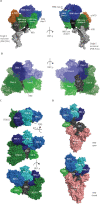Monoclonal antibody therapies against SARS-CoV-2
- PMID: 35803289
- PMCID: PMC9255948
- DOI: 10.1016/S1473-3099(22)00311-5
Monoclonal antibody therapies against SARS-CoV-2
Erratum in
-
Correction to Lancet Infect Dis 2022; published online July 5. https://doi.org/10.1016/S1473-3099(22)00311-5.Lancet Infect Dis. 2022 Sep;22(9):e239. doi: 10.1016/S1473-3099(22)00468-6. Epub 2022 Jul 12. Lancet Infect Dis. 2022. PMID: 35839793 Free PMC article. No abstract available.
Abstract
Monoclonal antibodies (mAbs) targeting the spike protein of SARS-CoV-2 have been widely used in the ongoing COVID-19 pandemic. In this paper, we review the properties of mAbs and their effect as therapeutics in the pandemic, including structural classification, outcomes in clinical trials that led to the authorisation of mAbs, and baseline and treatment-emergent immune escape. We show how the omicron (B.1.1.529) variant of concern has reset treatment strategies so far, discuss future developments that could lead to improved outcomes, and report the intrinsic limitations of using mAbs as therapeutic agents.
Copyright © 2022 Elsevier Ltd. All rights reserved.
Conflict of interest statement
Declaration of interests AC is the Chair of the US National COVID-19 Convalescent Plasma Project and reports being part of the scientific advisory board of SAB Therapeutics, a company developing cow polyclonal antibodies. All other authors declare no competing interests.
Figures


References
-
- Barnes K. Milestone 2: the first monoclonal antibody therapy. Nature Protocols. December, 2018. https://media.nature.com/original/magazine-assets/d42859-018-00024-6/d42...
-
- El Abd Y, Tabll A, Smolic R, Smolic M. Mini-review: the market growth of diagnostic and therapeutic monoclonal antibodies—SARS CoV-2 as an example. Hum Antibodies. 2022;30:15–24. - PubMed
Publication types
MeSH terms
Substances
LinkOut - more resources
Full Text Sources
Other Literature Sources
Medical
Miscellaneous

